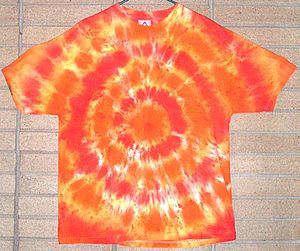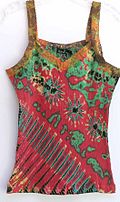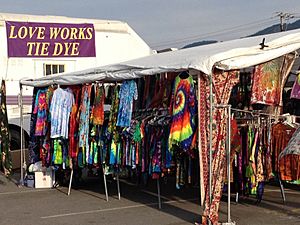Tie-dye facts for kids

Tie-dye is a fun way to create colorful patterns on fabric. It's a modern name for an old art form. People make tie-dye by folding, twisting, or crumpling fabric. Then they tie it tightly with string or rubber bands. After that, they add dye to the fabric.
The parts of the fabric that are tied stay lighter or don't get colored at all. This is because the ties "resist" the dye. More complex tie-dye designs can involve many steps. This includes dyeing the fabric, then tying it again, and dyeing it with new colors.
Tie-dye is known for its bright, bold colors and cool patterns. You often see designs like spirals, peace signs, or mandalas. While many tie-dye items are now made in factories, some artists still create unique pieces. They might use simple designs or different fabrics.
Contents
How to Make Tie-Dye Patterns
Tie-dye lets you make many different designs on fabric. You can create spirals, peace signs, diamonds, or marble effects. You can even use stencils or special clamps to make shapes. Another method is called tritik, where you stitch and gather the fabric.
If you use a modern tie-dye kit, it's usually easy to make a spiral or a circle design.
History of Tie-Dye
Tie-dye techniques have been used for a very long time around the world.
Early Examples of Tie-Dye
Some of the oldest examples of tie-dye come from China. These date back to the 5th century. In Peru, ancient tie-dye fabrics have been found from 500 to 810 AD. These old Peruvian designs show small circles and lines. They used bright colors like red, yellow, blue, and green.
Tie-Dye in Asia
Shibori is a type of tie-dye from Japan. People have been doing shibori there since the 8th century. Shibori uses many detailed tying methods. This includes stitching patterns and gathering the fabric tightly before dyeing. These methods create amazing designs, often for traditional kimono clothes. Another shibori way is to wrap fabric around a rope or wood. Then it's tied tightly with string. The parts under the ties or against the core stay undyed.
In Indonesia, especially on the island of Java, tie-dye is called jumputan. Other Indonesian words for tie-dye methods are plangi and tritik. Sometimes, tie-dye is mixed with other dyeing styles. For example, batik jumputan combines tie-dye with batik wax-resist dyeing.
In India, a term called Bandhna is used. This leads to the famous Bandhani fabrics from the Kutch district. Ikat is another method. It involves tie-dyeing the threads before the cloth is woven.
Mudmee tie-dye comes from Thailand and parts of Laos. It uses different shapes and colors. The colors are often softer, and the main background color is usually black.
Tie-Dye in Africa
Tie-dye methods have been used for hundreds of years in West Africa. The Hausa people in Nigeria are known for their deep indigo dye pits. They create beautiful tie-dyed clothes. These clothes are then often decorated with rich embroidery. Some people think these African techniques might have inspired the tie-dye fashion of the 1960s.
Tie-Dye in the Western World
Tie-dye was known in the United States by 1909. A professor named Charles E. Pellow from Columbia University showed how to do it.
While some tie-dye was seen in Western fashion before the 1960s, it became very popular in the late 1960s. Rock stars like Janis Joplin and John Sebastian helped make it famous. John Sebastian even dyed his own clothes!
Tie-dye became a popular and affordable way to make clothes unique. People used inexpensive T-shirts, jeans, and other items. They turned them into bright, colorful creations. Companies like Water Baby Dye Works and Up Tied became well-known for their tie-dye art. Up Tied even won an award for its creative fabrics in 1970. They made tie-dyed velvets and silks for famous designers.
See also
 In Spanish: Tie-dye para niños
In Spanish: Tie-dye para niños




